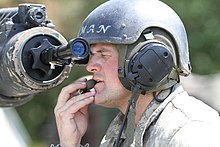Zeroing in (calibration)

The shooting in the calibration of the aiming devices like the open sight , the telescopic sight or the reflex sight on the firearm . In addition, other factors such as ammunition used and the shooter's eye are included in the calibration . Sighting in takes place after the assembly of aiming aids or after targeting aids have been damaged or hit against objects. Since the point of impact from shooter to shooter and the ammunition of a manufacturer can sometimes vary considerably from production lot to production lot, as well as from manufacturer to manufacturer, the weapon must be aimed at the respective shooter and the respective ammunition lot.
In handguns the targeting aid is adjusted according to the results for the first three shots that these approaches the target center point of a Anschussscheibe passes - with additional shots are then further corrections performed.
When a weapon is placed (on a target or a sandbag ), with less ammunition - shooting position in a sitting position - the aiming aid can be adjusted by a helper after the shooter has announced that this and the first shots are congruent. The shooter must keep the weapon unchanged on the point of the first agreement. With the next shot, which is fired at the center of the target, the weapon is usually already in.
Problems can arise if there are technical defects in the aiming aid of the weapon or its assembly that are not recognized at first. If there are unexpected hits, a technical problem such as a damaged aiming aid is to be suspected, rarely missed shots by the shooter.
The handgun, the ammunition, the rest and the shooter are to be seen as a complete system . That means: only the shooter of a weapon can shoot it in for himself . The barrel of the weapon must not rest on or against it (so that it can swing freely). A rifle should be shot "off the shoulder", a pistol / revolver "out of the hands". Jigs and laser test aids cannot replicate the shooter and his eye (or eyes with a reflex sight). Ideally, the fore-end and the end of the rear end of the rifle rest on a sandbag for a “soft” rest, while the underside of the grip and the underside of the grip are ideal for pistols or revolvers; the stop is the one that is usually applied in use.
A boresight can be used for a rough adjustment of the aiming aid before shooting in . This saves a lot of test shots. The traditional approach without a boresighter is to look through the barrel, aim at a target, and aim at the same target with the aiming aid. This procedure is particularly suitable for drop barrel weapons ; For many other types of weapons, however, it is time-consuming because the breech must first be removed.
Sighting in is a method of indirect shooting, especially for artillery, if there is no basis for an accurate calculation method. The sighting-in can take place either directly at the target or at a sighting-in point.
The term is also used for a method of indirect shooting , especially artillery ; see shooting in (indirect fire) .
Web links
Individual evidence
- ↑ Jim Casada: The Marksmanship Primer: The Experts' Guide to Shooting Handguns and Rifles , Skyhorse Publishing, 2013, ISBN 9781510720374 , p. 73 [1]
- ↑ David Watson: ABCs of Rifle Shooting , Gun Digest Books, 2013, ISBN 9781440239038 , pp. 192–193 [2]

